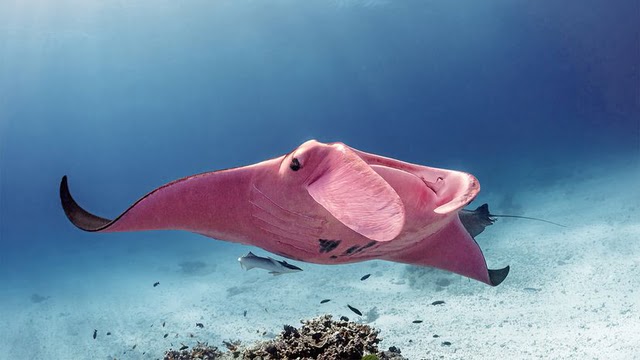Quck answer
Inspector Clouseau is a rare and fascinating manta ray that has been spotted off the coast of Australia. What makes Inspector Clouseau so unique is his bright neon pink color, caused by a genetic mutation. This mutation is incredibly rare and has only been documented a few times in manta rays. The discovery of Inspector Clouseau has been exciting for marine biologists, who are able to study this fascinating creature up close. Despite his unusual appearance, Inspector Clouseau is just like any other manta ray, feeding on plankton and swimming gracefully through the water. His striking coloration serves as a reminder of the beautiful diversity of life in our oceans.
Wild Animals

A certain reef manta ray (Mobula alfredi) living off the coast of Queensland, Australia has become an internet sensation due to his unique pink coloring. Affectionately named Inspector Clouseau after the bumbling detective in the “Pink Panther” movie franchise, this stunning creature has been spotted about 10 times since he was first discovered in 2015. He is believed to be the only neon pink manta ray in the world and is often seen flashing his shocking pink flippers at marine life and humans alike.
The reef manta ray is one of the largest ray species in the world, but their palette is typically pretty subdued in color — normally white with a few black splotches. The reason behind Inspector Clouseau’s pink color is still a mystery to scientists, but the current theory is that it’s the result of a rare genetic mutation known as erythrism, which causes the skin to take on a red or pink hue. While some gene mutations can cause commonly-known conditions such as albinism or melanism, Clouseau is the first documented case of a manta ray with erythrism.
In February of 2020, a photographer named Kristian Laine snapped some photos of a group of male manta rays hot on the trail of a female’s pheromone trail. One ray in particular caught his attention due to its unusual color. After consulting with locals, he discovered the animal he saw was Inspector Clouseau, a local celebrity.

It’s not just flamingos that achieve a pink hue through their diet. Some animals are born with erythrism, while others achieve it through their diet. Flamingos, for instance, are pink because they eat brine shrimp, which contain a pigment called canthaxanthin.
FAQ
1. What is Inspector Clouseau?
Inspector Clouseau is a manta ray that has been spotted off the coast of Australia. What makes him unique is that he is neon pink, which is not a common color for manta rays.
2. How did Inspector Clouseau get his name?
Inspector Clouseau is named after the bumbling detective in the Pink Panther movies. The name was given to him by marine biologist Asia Armstrong, who first spotted him.
3. Why is Inspector Clouseau pink?
No one is quite sure why Inspector Clouseau is pink. It could be due to a genetic mutation or a diet rich in pink plankton. Regardless of the cause, he certainly stands out from other manta rays.
4. Where can I see Inspector Clouseau?
Inspector Clouseau has been spotted in the waters around Lady Elliot Island, which is part of the Great Barrier Reef. However, manta rays are known to travel great distances, so he could show up in other parts of Australia or even in other countries.
5. Is Inspector Clouseau in danger?
It’s hard to say whether Inspector Clouseau is in danger, but manta rays in general face threats such as overfishing and habitat destruction. It’s important for us to protect these gentle giants and their habitats.
6. What do manta rays eat?
Manta rays primarily feed on plankton, which they filter from the water using their gills. They can eat up to 60 pounds of plankton in a single day!
7. How big do manta rays get?
Manta rays are one of the largest species of fish, with a wingspan that can reach up to 23 feet. However, most manta rays are smaller than this, with an average wingspan of around 10 to 14 feet.
8. Are manta rays dangerous?
No, manta rays are not dangerous to humans. In fact, they are known for their gentle nature and often approach divers and snorkelers out of curiosity. However, it’s important to give them space and not touch them or interfere with their behavior.
9. How can I help protect manta rays?
You can help protect manta rays by supporting conservation efforts and avoiding activities that harm their habitats, such as overfishing and pollution. You can also choose to go on eco-friendly tours that prioritize the well-being of marine life.
10. What other unique marine creatures can I see in Australia?
Australia is home to a wide variety of unique marine creatures, including whale sharks, dugongs, and sea dragons. There are also many species of colorful reef fish and coral to see.
11. Can I swim with manta rays?
Yes, you can swim with manta rays on guided tours. However, it’s important to choose a responsible tour operator that prioritizes the safety and well-being of the animals.
12. What should I do if I see a manta ray?
If you see a manta ray while snorkeling or diving, it’s important to give them space and not touch them. Enjoy the experience from a distance and let these gentle giants go about their business.





Leave a Reply